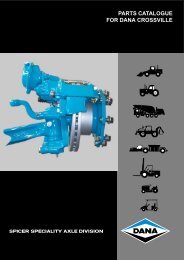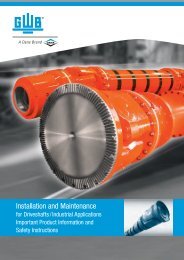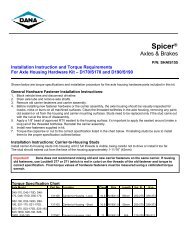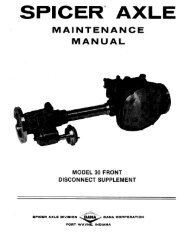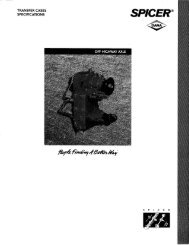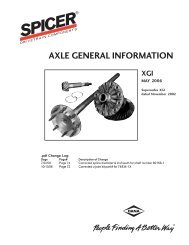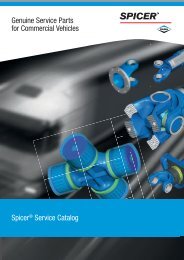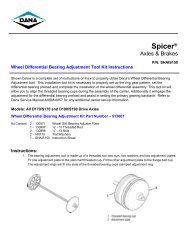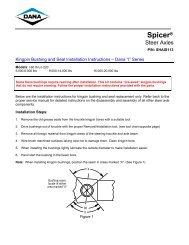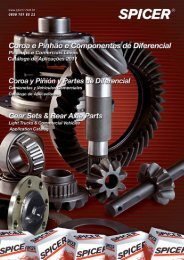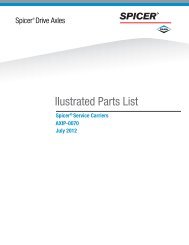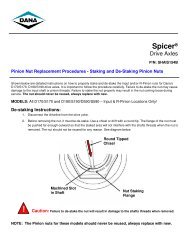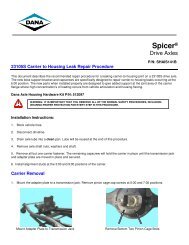Front and Rear Axle Catalog - Spicer
Front and Rear Axle Catalog - Spicer
Front and Rear Axle Catalog - Spicer
You also want an ePaper? Increase the reach of your titles
YUMPU automatically turns print PDFs into web optimized ePapers that Google loves.
X510-8<br />
How Limited Slip Differentials Operate<br />
A conventional differential transmits all the ring gear torque through the differential gears to the axle shafts.<br />
Torque is at all times equal on the axle shafts, <strong>and</strong> if one wheel slips, the other wheel can only put out as<br />
much torque as the slipping wheel.<br />
The <strong>Spicer</strong> Limited Slip differential has the same power flow as a conventional differential, plus a more direct<br />
flow which automatically takes effect as driving conditions dem<strong>and</strong>. This more direct power flow is from the<br />
differential case to each axle shaft through a clutch plate <strong>and</strong> disc arrangement.<br />
Arrangement of these plates <strong>and</strong> discs is at the option of the vehicle manufacturer, so care should be taken<br />
during disassembly to note the arrangement of these components.<br />
The Limited Slip construction permits differential action when required for turning corners <strong>and</strong> transmits<br />
equal torque to both wheels when driving straight ahead. However, when one wheel tries to spin due to<br />
leaving the ground, a patch of ice, etc., the clutch packs automatically provide more torque to the wheel<br />
which is not trying to spin.<br />
The Limited Slip differential resists wheel spin on bumpy roads <strong>and</strong> provides more pulling power when one<br />
wheel tries to slip. In many cases of differences in traction, pulling power will be automatically provided until<br />
both wheels start to slip.<br />
In diagnosis of vehicle operators' complaints, it is important to recognize two things.<br />
1. If, with unequal traction, both wheels slip, the Limited Slip Differential has done all it can pssibly do.<br />
2. In extreme cases of differences in traction, the wheel with the least traction may spin after the Limited<br />
Slip has transferred as much torque as possible to the non-slipping wheel.<br />
How To Distinguish a Powr-Lok from a Trac-Lok<br />
All Models except Model 80 /286: The Powr-Lok<br />
design is identified by its 2-piece case. The Trac-Lok<br />
design is identified by its 1-piece case.<br />
Model 80 /286 only: Both the Powr-Lok <strong>and</strong> the Trac-<br />
Lok use 2-piece cases in the model 80 (286) axle.<br />
The difference between the two is in the shape of the<br />
holes for the cross shaft. The Powr-Lok case will have<br />
cross shaft holes that are "U" shaped in one case half<br />
<strong>and</strong> "V" shaped in the other case half. The Trac-Lok<br />
case will have cross shaft holes that are semicircles in<br />
both case halves.<br />
It is also possible to replace an existing Powr-Lok unit<br />
with a complete Trac-Lok unit. For this purpose, the<br />
differential case assembly must be replaced.<br />
POWR-LOK<br />
2-Piece Case<br />
4-Pinion Mate Gears<br />
How To Obtain Special Service Tools<br />
Special service tools (see service manuals) can be obtained from the following company:<br />
Kent-Moore<br />
OE Tool <strong>and</strong> Equipment Group<br />
SPX Corporation<br />
28635 Mound Road<br />
Warren MI 48092-3499<br />
(800) 345-2233<br />
TRAC-LOK<br />
1-Piece Case<br />
2-Pinion Mate Gears<br />
v



